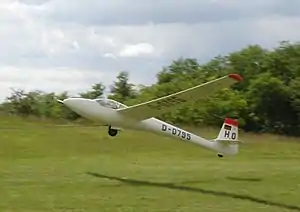| H-301 Libelle | |
|---|---|
 | |
| H-301 being launched by winch | |
| Role | 15-metre class sailplane |
| National origin | Germany |
| Manufacturer | Glasflügel |
| First flight | 1964 |
| Number built | 111 |
The Glasflügel H-301 Libelle is an early composite single-seat sailplane produced by Glasflügel from 1964 to 1969. The H-301 had camber-changing wing flaps so was required to compete in the Open Class because the Standard Class excluded wing flaps. It was often known as the Open Class Libelle.
Development
In 1964 the H-301 Libelle ("Dragonfly") received the first German and first U.S. Type Certificate issued to an all-fiberglass aircraft. It had flaps, water ballast and retractable landing gear.
There are two canopy variants: the normal canopy and a sleeker, lower-profiled 'racing' canopy with no side vent. The canopy is unique in that it has a catch that enables the front to be raised by 25 mm (1 in) in flight to provide a flow of ventilating air instead of the more conventional small sliding panel used for this purpose.
The American Wil Schuemann pioneered several performance-enhancing modifications to the type, including a re-profiled wing, converting the airfoil to a Wortmann section, various fairings, a new canopy and a reshaped fuselage nose. Aircraft incorporating these changes are informally known as 'Schümanised' Libelles.[1]
Design
- Wings: spar and shell of balsa or foam / reinforced plastic sandwich
- Ailerons: balsa or synthetic foam / reinforced plastic sandwich.
- Horizontal stabilizer: reinforced plastic
- Elevator: reinforced plastic
- Automatic connections for airbrakes, flaps and elevator. Ailerons are connected by a "pip" pin
The H-201 Standard Libelle was developed in 1967 as a Standard Class variant.
The Libelle was a popular and influential design. Its light wings and easy rigging set a new benchmark.
Handling is generally easy except that it is sensitive to sideslipping and has relatively ineffective airbrakes that make short landings tricky for inexperienced pilots.
The H-201 Libelle (standard class) was superseded by the Hornet.
The H-301 Libelle (open class) was superseded by the Mosquito.
Specifications
General characteristics
- Crew: 1
- Capacity: 50 kg (110 lb) water ballast
- Length: 6.19 m (20 ft 4 in)
- Wingspan: 15.00 m (49 ft 3 in)
- Height: 1.25 m (4 ft 1 in)
- Wing area: 9.5 m2 (102 sq ft)
- Aspect ratio: 23.6
- Empty weight: 180 kg (400 lb)
- Gross weight: 300 kg (660 lb)
Performance
- Maximum speed: 200 km/h (124 mph, 108 kn)
- Maximum glide ratio: ca. 39
- Rate of sink: 0.55 m/s (108 ft/min)
See also
Aircraft of comparable role, configuration, and era
Related lists
References
- ↑ Rogers, Bennett: 1974 Sailplane Directory, Soaring Magazine, page 52. Soaring Society of America, August 1974. USPS 499-920
- Thomas F, Fundamentals of Sailplane Design, College Park Press, 1999
- Simons M, Segelflugzeuge 1965–2000, Eqip, 2004
- Sailplane Directory